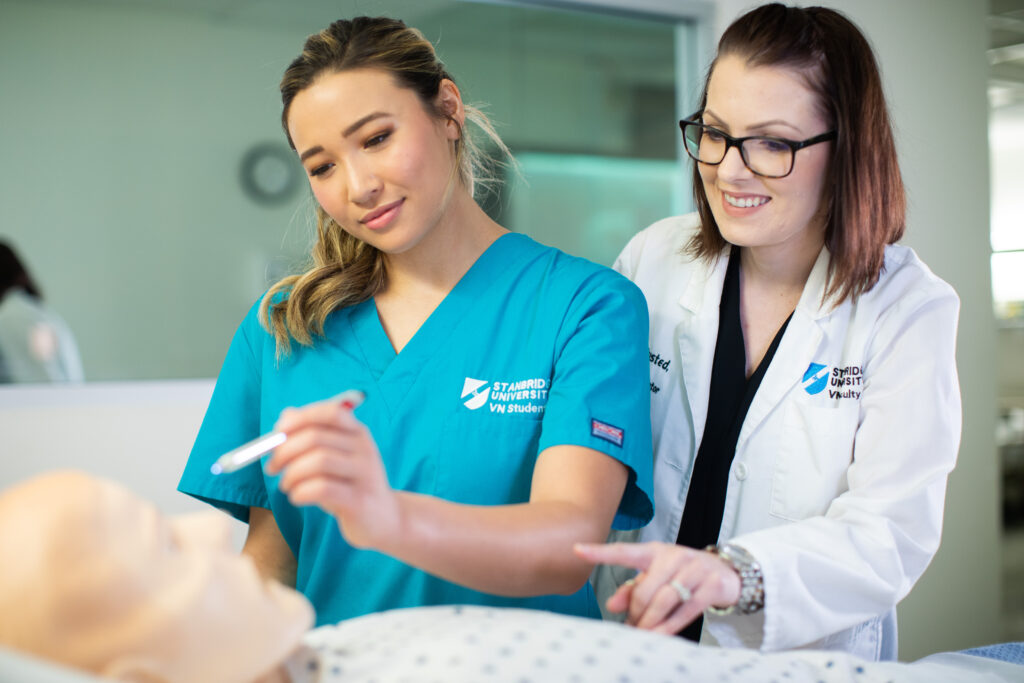LVN and BSN vs MSN: How to Choose the Right Nursing Path for Your Future

TL;DR: LVN vs. BSN vs. MSN
- LVN: One of the quickest paths to entry-level nursing. Hands-on training. Perfect for starting a career in patient care.
- BSN: Undergraduate degree leading to RN licensure and broader responsibilities in clinical settings.
- MSN: Graduate degree for leadership, education, or advanced clinical practice. Often chosen by nurses seeking career advancement.
Nursing is more than a profession; it’s a calling. Whether you’re just starting your education or looking to advance your career, understanding the differences between the MSN vs. BSN vs. LVN programs can shape your trajectory in powerful ways. Each degree comes with different responsibilities, time commitments, and professional outcomes.
Each program prepares you for different levels of nursing. And most importantly, they often build on each other. An MSN isn’t a separate route from a BSN; it’s the next step. That’s why it’s helpful to see these options not just as choices, but as stages.
Comparing the Paths: LVN, BSN, and MSN
Explore distinct pathways in nursing, LVN, BSN, and MSN (an option offered after BSN completion), each offering unique opportunities for career growth, clinical impact, and educational advancement.
Licensed Vocational Nurse (LVN)
LVN training is an entry-level nursing credential that focuses on core clinical skills, including monitoring vital signs, assisting with patient hygiene, and administering medication. Stanbridge University full-time LVN students typically complete the program in 17 to 19 months, with part-time options available.¹
As specified by the US Bureau of Labor Statistics, LVNs are authorized to work under the supervision of RNs or doctors and are essential to bedside care.²
Bachelor of Science in Nursing (BSN)
A BSN is a 36 to 37-month undergraduate degree designed to prepare students for RN licensure and long-term growth.¹ BSN students at Stanbridge University dive deeper into clinical care, health assessment, and nursing leadership. Graduates of our BSN program are eligible for NCLEX-RN and California RN licensure. In 2023–2024, Stanbridge’s BSN program reported a 100% NCLEX-RN pass rate.³
As a BSN graduate, your path to RN licensure starts here. According to the US Bureau of Labor Statistics, Registered nurses (RNs) provide and coordinate patient care, educate patients and the public about various health conditions, and provide advice and emotional support to patients and their families.⁴

Master of Science in Nursing (MSN)
The MSN is a graduate-level program that typically builds on BSN education. As the US Bureau of Labor Statistics notes, the program opens doors to nurse educator roles, healthcare leadership, and advanced clinical work⁵. The MSN-Ed program offered by Stanbridge is delivered online through Edverum™, a platform tailored for working nurses.
The curriculum includes applied research, advanced teaching methods, and a capstone practicum in the community. Our MSN program helps nurses transition into roles where they mentor, teach, and lead within the healthcare system, equipping the next generation of care providers.
If you’re considering this path, Stanbridge offers the MSN-Ed program at no cost for eligible Stanbridge University BSN graduates.⁶
MSN degrees can prepare graduates for roles in nurse education, healthcare administration, and advanced clinical practice.⁵

How to Choose What’s Right for You
If you’re drawn to direct patient care and want to enter the workforce quickly, the LVN path could be the right choice. If you’re aiming for RN licensure and greater responsibilities, a BSN prepares you for that next level.
And when you’re ready to guide others, shape policy, or teach future nurses, the MSN is your next step. Choosing between BSN vs MSN isn’t about picking one over the other. It’s about understanding how they build on each other and where you see yourself five or ten years from now.
Start Your Journey in Nursing
Whether you’re taking the first step or continuing your path, Stanbridge University offers the education, support, and technology to help you thrive. Would you like to learn more about the difference between a Master’s in Nursing vs a Bachelor’s in Nursing?
Explore upcoming start dates, tour the labs, or connect with our admissions team by attending a BSN information session. Visit the Stanbridge University BSN program page to learn more.
Frequently Asked Questions:
No. An LVN is an entry-level credential, while a BSN is a full undergraduate degree with more responsibilities and opportunities.
Yes. An MSN builds on a BSN with graduate-level training and specialization, enabling roles in education, leadership, and advanced clinical practice.
At the pinnacle of nursing careers are titles like Chief Nursing Officer (CNO), Nurse Practitioner (NP), and Doctor of Nursing Practice (DNP). While the BSN and MSN programs are crucial steps, many nurses choose to further their education with a DNP or PhD to reach executive or highly specialized positions.
A BSN is an undergraduate degree that prepares nurses for clinical practice and RN licensure, while an MSN is a graduate degree that prepares nurses for advanced roles in leadership, education, or specialty practice.
An MSN degree is ideal for nurses who want to move into leadership, policy, education, or advanced clinical roles such as Nurse Practitioner (NP) or Nurse Educator.
Yes, as directed by the Bureau of Labor Statistics (BLS), most MSN programs, including Stanbridge University’s, require applicants to hold a BSN or a closely related bachelor’s degree in healthcare.⁵ Graduates of Stanbridge University’s BSN program can take the MSN-Ed program at no cost.⁶
¹Program duration subject to change. Completion times vary depending on the start and end dates of a cohort and any individual circumstances that may impact progression.
²Source: Bureau of Labor Statistics, U.S. Department of Labor, Occupational Outlook Handbook, Licensed Practical and Licensed Vocational Nurses, https://www.bls.gov/ooh/healthcare/licensed-practical-and-licensed-vocational-nurses.htm. As viewed on January 10, 2025.
³Source: The California Board of Registered Nursing, NCLEX-RN pass rate, NCLEX-RN, Associate of Science in Nursing (ADN) program, 2021/2022 to 2022/2023, Bachelor of Science in Nursing (BSN) program, 2023/2024; http://www.rn.ca.gov/education/passrates.shtml. As viewed on January 10, 2025.
⁴Source: Bureau of Labor Statistics, U.S. Department of Labor, Occupational Outlook Handbook, Registered Nurses, https://www.bls.gov/ooh/healthcare/registered-nurses.htm. As viewed on January 10, 2025.
⁵Source: Bureau of Labor Statistics, U.S. Department of Labor, Occupational Outlook Handbook, Nurse Anesthetists, Nurse Midwives, and Nurse Practitioners, https://www.bls.gov/ooh/healthcare/nurse-anesthetists-nurse-midwives-and-nurse-practitioners.htm. As viewed on January 10, 2025.
⁶The MSN-Ed program is available at no cost to Stanbridge University Bachelor of Science in Nursing graduates who began their program on or after August 2024 and who enroll in the Master of Science in Nursing Education program beginning immediately after graduating and obtaining their NCLEX-RN licensure.